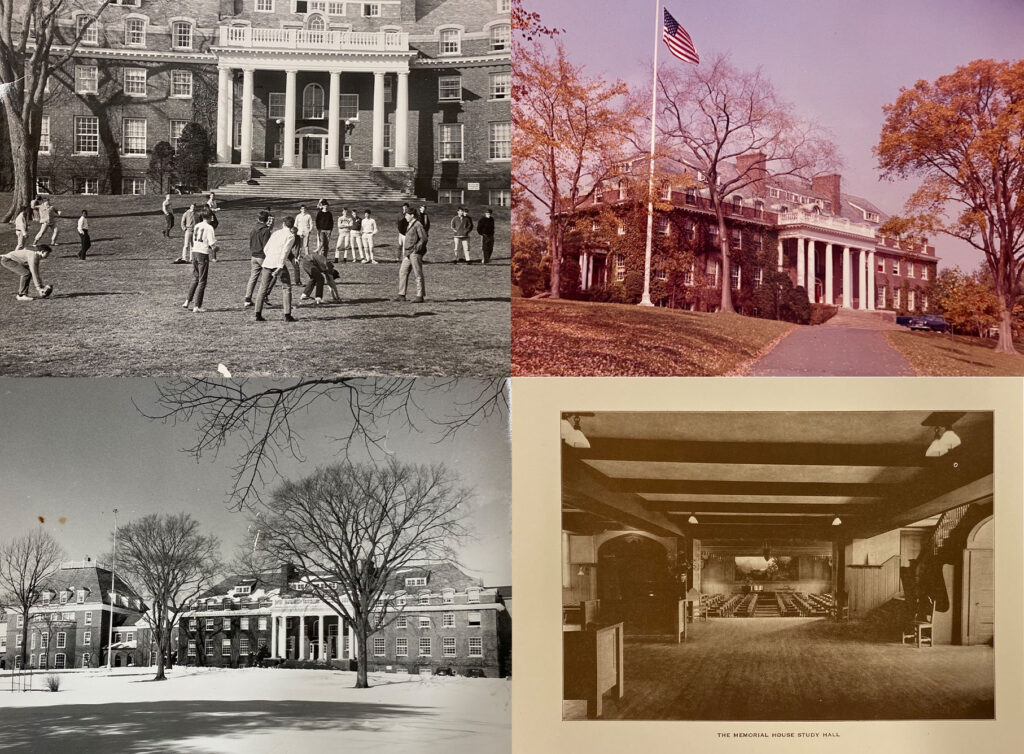
Photo courtesy of the Choate Archives
When freshmen boys arrive at Choate, they move into one of the School’s most historic buildings: Memorial House, affectionately known as Mem. The story of Memorial House traces back to George St. John’s arrival to campus as the third long-term headmaster of the Choate School in 1908. Upon a handshake with Choate’s founder, Judge William Gardner Choate, St. John began his tenure as headmaster over Choate’s less than ten acres and 65 boys. Regardless, St. John had big plans for the School.
Before World War I, the Choate School was set on a promising trajectory. Hill House had been newly completed in 1911, and campus life was finally starting to reflect St. John’s goals for the School. “The reason we can’t do more individual work is because the school is small,” St. John noted in 1908 in his memoir Forty Years at School. “If Choate were larger, there would be enough boys with practically the same needs to make divisions in each subject suited to each one.” So, in hopes to bring greater specialization to students, St. John helped enrollment numbers increase fivefold within his first ten years at Choate. Soon, the Choate School had gained national recognition.
However, the war marked the beginning of a challenging period for the Choate School. Although the battlefield seemed far from campus, its impact reached close to home. Linked under a common cause, both the Choate School and Rosemary Hall modified daily life to support the war effort. Boys as young as 15 drilled in squads while the rest of campus, including Rosmarians over in Greenwich, worked tirelessly to raise funds and volunteer at the home front.
When the conflict ended in 1918, Choate and Rosemary tried to return to a regular schedule. Still, the death of 16 Choate alumni had bequeathed grief on campus. Crisis soon followed with the first flu pandemic, dropping both schools’ morales to all-time lows.
By the early 1920s, however, Choate regained its footing, emerging with a new building in plan. With more than 250 students living on campus, Choate was in need of a new dormitory, one that St. John aspired to fit perfectly on campus while recognizing — or memorializing — the fallen alumni. Thus, with the financial support of 436 alumni and parents, the construction of Memorial House began. The building was designed by Francus E. Walterman and was dedicated on May 30, 1921.
The large Georgian-Revival style building mirrored Hill House across Christian Street, emphasizing Choate’s grit and ambition to be a leading educational institution.
Once constructed, Memorial House served as Choate’s lower school where second-formers — students at Choate’s lower school — lived, ate, and studied. It contained a large room in the north wing — which has long been converted to separate dorm rooms — lined with 100 desks where students sat for study hours every night. HPRSS and English teacher and Memorial House adviser Mr. Ned Gallagher said, “Memorial House has always been where the youngest boys in the School have lived. In fact, the apartment where I live is the site of the old Refectory, which was a satellite of the main dining hall.”
Memorial House has retained some impressive historical artifacts that reflect its past. The mural above the common room fireplace lists the names of the 16 Choate students who died in the war. The Hatch study, located in the left of the common room, is named after Edward Hatch, one of those young men.
Memorial House advisers like Mr. Gallagher find it frustrating how little today’s students know of Memorial House’s history. “The very first night third-formers arrive at school, we spend time talking in a house meeting about the name of the building, its history, and the ethos we aspire to together.” Mr. Gallagher said. “But other than that, the history is rarely mentioned.”
The lack of knowledge about the history of Memorial House is just one aspect of the underlying problem HPRSS teacher Mr. Jonas Akins hopes to address in his course development grant this summer.
He plans to put together a course that would teach the history of not only Memorial House, but also the Quinnipiac land on which the Choate campus sits, the town of Wallingford, Rosemary Hall, and the Choate School.
We often forget the history that surrounds us at Choate — more than a hundred years’ worth of memories established in the very buildings and paths we wander everyday. So, while walking around Memorial House next time, take a moment to consider its history and perhaps even educate a friend.




